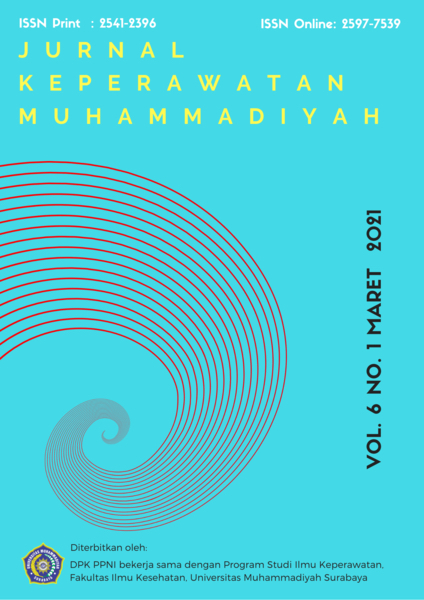ASI Ekslusif, Perilaku Orang Tua Dalam Pemberian Makan Dan Kejadian Stunting Pada Anak Usia 1-3 Tahun
DOI:
https://doi.org/10.30651/jkm.v6i1.6134Keywords:
Stunting, Feeding Behavior, Exclusive breastfeedingAbstract
Stunting is one of the nutritional problems that occur in toddlers due to chronic malnutrition. Chronic malnutrition is closely related to the ineffectiveness of exclusive breastfeeding, poor parenting, especially the behavior of mothers in feeding toddlers, this is because mothers have a major role, especially in choosing and preparing food to be consumed by toddlers. The phenomenon that occurred at the Posyandu Anggrek, Mulyorejo, Surabaya, was found that some children had a height that was not suitable for their age and some parents only gave formula milk when the child did not want to eat. The purpose of this study was to analyze the relationship between exclusive breastfeeding, parental behavior in feeding toddlers with stunting. The study design uses a cross-sectional design. Respondents were 22 mothers in Posyandu Anggrek 2, Mulyorejo Subdistrict, Surabaya, who fulfilled the inclusion and exclusion criteria. Stunting in toddlers is assessed based on z-score Height/ Age. Exclusive breastfeeding was assessed using a questionnaire. Maternal behavior in feeding is measured using the Parental Feeding Behaviors Questionnaire (PFBQ) questionnaire. Fisher's Exact Test statistic test results show there is a relationship between exclusive breastfeeding and parental behavior in feeding children with stunting in children aged 1-3 years (p = 0.002; p = 0.015). Exclusive breastfeeding and proper feeding behavior are important to prevent stunting in children.
References
Badan Penelitian dan Pengembangan Kementerian Kesehatan RI. (2018). Laporan Nasional Riskesdas 2018. Jakarta: Kementerian Kesehatan RI. https://doi.org/10.1017/CBO9781107415324.004
Danaei, G., Andrews, K. G., Sudfeld, C. R., Fink, G., McCoy, D. C., Peet, E., … Fawzi, W. W. (2016). Risk Factors for Childhood Stunting in 137 Developing Countries: A Comparative Risk Assessment Analysis at Global, Regional, and Country Levels. PLoS Medicine, 13(11), 1–18. https://doi.org/10.1371/journal.pmed.1002164
Dinkes Provinsi Jawa Timur. (2019). Profil Kesehatan Jawa Timur Tahun 2018. Surabaya: Dinas Kesehatan Provinsi Jawa Timur. Surabaya: Dinas Kesehatan Provinsi Jawa Timur. Retrieved from https://www.google.com/search?client=firefox-b-d&ei=zxpWXtieKq6c4
Francisco, J., Ferrer, L., & Serra-majem, L. (2017). Factors Associated with Stunting among Children Aged 0 to 59 Months from the Central Region of Mozambique. Nutrients, 9, 1–16. https://doi.org/10.3390/nu9050491
Handayani, S., Kapota, W. N., & Oktavianto, E. (2019). Hubungan Status ASI Ekslusif dengan Kejadian Stunting Pada Batita Usia 24-36 Bulan di Desa Watugajah Kabupaten Gunung Kidul. Jurnal Medika Respati, 14(4), 287–300.
Ibrahim, I. A., & Faramita, R. (2014). Hubungan Faktor Sosial Ekonomi Keluarga dengan kejadian Stunting Anak Usia 24-59 Bulan di Wilayah Kerja Puskesmas Barombong Kota Makasar Tahun 2014. Al-Sihah : Public Health Science Journal, VI(2), 63–75.
Izwardy, D. (2018). Praktik Pemberian Makanan Bayi dan Anak (PMBA) Untuk Perubahan Perilaku Pemenuhan Asupan Gizi Anak Dalam Upaya pencegahan Stunting. Serpong: Kementerian Kesehatan RI 2018.
Izwardy, D. (2019). Kebijakan dan strategi penanggulangan stunting di indonesia. FGD Skrining Malnurisi Pada Anak dI Rumah Sakit. Jakarta.
Jannah, A. ul, & Putra, W. S. (2017). Kesalahan-Kesalahan Fatal (yang Harus Dihindari) Orangtua dalam Merawat & Mendidik Buah Hati. Yogyakarta: Ar-Ruzz Media.
Kementerian Kesehatan Republik Indonesia. (2018). Hasil Utama Riset Kesehatan Dasar Jawa Timur 2018. Badan Penelitian dan Pengembangan Kesehatan, Kementrian Kesehatan Republik Indonesia. Jakarta: Badan Penelitian dan Pengembangan Kesehatan, Kementrian Kesehatan Republik Indonesia.
Kementerian Kesehatan RI. (2018). Situasi Balita Pendek (Stunting) di Indonesia. Buletin Jendela Data Dan Informasi Kesehatan, 1–43.
Khan, N., & Islam, M. M. (2017). Effect of exclusive breastfeeding on selected adverse health and nutritional outcomes : a nationally representative study. BMC Public Health, 17, 1–7. https://doi.org/10.1186/s12889-017-4913-4
Lusmilasari, L., Chaiyawat, W., & Rodcumdee, B. (2015). The development of the parental feeding behaviours questionnaire for Indonesian parents with toddlers : preliminary result. International Journal of Community Medicine and Public Health, 2(4), 558–565.
Muldiasman, Kusharisupeni, & Laksminingsih, E. (2018). Can early initiation to breastfeeding prevent stunting in 6 – 59 months old children ? Journal of Health Research, 32(5), 334–341. https://doi.org/10.1108/JHR-08-2018-038
Persatuan Ahli Gizi Indonesia. (2018). Stop Stunting dengan Konseling Gizi. Jakarta: Penebar Swadaya Grup.
Rahmayana, Ibrahim, I. A., & Damayati, D. S. (2014). Hubungan Pola Asuh Ibu Dengan Kejadian Stunting Anak Usia 24-59 Bulan di Posyandu Asoka II Wilayah Pesisir Kelurahan Barombong Kecamatan Tamalate Kota Makasar Tahun 2014. Public Health Science Journal, 6(2).
Rusilanti, Dahlia, M., & Yulianti, Y. (2015). Gizi Dan Kesehatan Anak Pra Sekolah. Bandung: PT Remaja Rosdakarya.
Rusmil, V. K., Ikhsani, R., Dhamayanti, M., & Hafsah, T. (2019). Hubungan Perilaku Ibu dalam Praktik Pemberian Makan pada Anak Usia 12-23 Bulan dengan Kejadian. Departemen Ilmu Kesehatan Anak Fakultas Kedokteran Universitas Padjadjaran/RSUP Dr. Hasan Sadikin, Bandung, 20(6), 1–5. Retrieved from https://www.researchgate.net/publication/333169080
Septikasari, M. (2018). Status Gizi Anak dan Faktor yang Mempengaruhi. Yogyakarta: UNY Press.
Setiawan, B. (2018). Faktor-faktor Penyebab Stunting Pada Anak Usia Dini. Bekasi: Yayasan Rumah Komunitas Kreatif.
Sudershan, R. V., Rao, G. M. S., Rao, P., Rao, M. V. V., & Polasa, K. (2008). Food safety related perceptions and practices of mothers – A case study in Hyderabad, India. Food Control, 19(5), 506–513. https://doi.org/10.1016/j.foodcont.2007.05.017
Uliyanti, Tamtomo, D. G., & Anantanyu, S. (2017). Faktor yang berhubungan dengan kejadian Stunting Pada Balita Usia 24-59 Bulan. Jurnal Vokasi Kesehatan, 3(2), 67–77. Retrieved from http://ejournal.poltekkes-pontianak.ac.id/index.php/JVK
UNICEF. (2013). Improving Child Nutrition, the achievable imperative for global progress. New York: Nations Children’s Fund.
Walters, C. N., Rakotomanana, H., Komakech, J. J., & Stoecker, B. J. (2019). Maternal determinants of optimal breastfeeding and complementary feeding and their association with child undernutrition in Malawi ( 2015 – 2016 ). BMC Public Health, 19(1503), 1–12.
Winarni, S., & Purnama, N. L. A. (2018). Perilaku orang tua dalam pemberian makan dan perilaku makan anak usia 2-5 tahun. Jurnal Penelitian Kesehatan, 5(2), 44–52.
Winarsih. (2018). Pengantar Ilmu Gizi Dalam Kebidanan. Yogyakarta: Pustaka Baru Press.
Downloads
Published
Issue
Section
License
- Penulis tetap memegang hak atas karyanya dan memberikan hak publikasi pertama kepada jurnal ini yang secara simultan karya tersebut dilisensikan di bawah:Â Creative Commons Attribution-ShareAlike 4.0 International (CC BY-SA 4.0)













